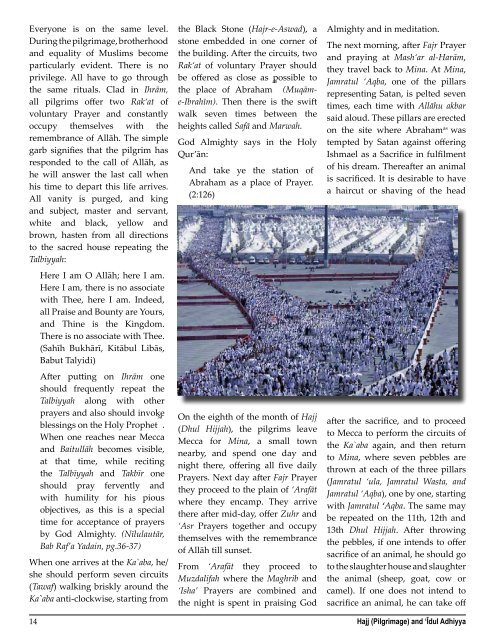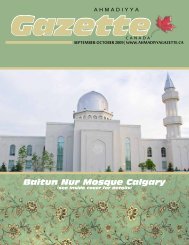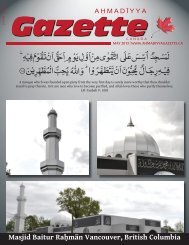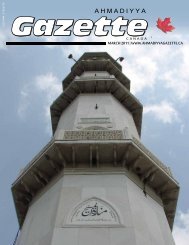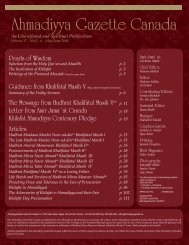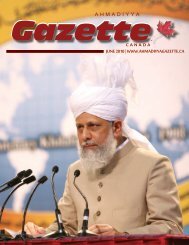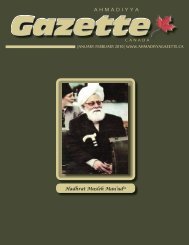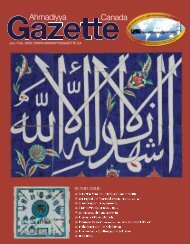English PDF - Ahmadiyya Gazette Canada
English PDF - Ahmadiyya Gazette Canada
English PDF - Ahmadiyya Gazette Canada
Create successful ePaper yourself
Turn your PDF publications into a flip-book with our unique Google optimized e-Paper software.
Everyone is on the same level.<br />
During the pilgrimage, brotherhood<br />
and equality of Muslims become<br />
particularly evident. There is no<br />
privilege. All have to go through<br />
the same rituals. Clad in Ihrām,<br />
all pilgrims offer two Rak‘at of<br />
voluntary Prayer and constantly<br />
occupy themselves with the<br />
remembrance of Allāh. The simple<br />
garb signifies that the pilgrim has<br />
responded to the call of Allāh, as<br />
he will answer the last call when<br />
his time to depart this life arrives.<br />
All vanity is purged, and king<br />
and subject, master and servant,<br />
white and black, yellow and<br />
brown, hasten from all directions<br />
to the sacred house repeating the<br />
Talbiyyah:<br />
Here I am O Allāh; here I am.<br />
Here I am, there is no associate<br />
with Thee, here I am. Indeed,<br />
all Praise and Bounty are Yours,<br />
and Thine is the Kingdom.<br />
There is no associate with Thee.<br />
(Sahīh Bukhārī, Kitābul Libās,<br />
Babut Talyidi)<br />
After putting on Ihrām one<br />
should frequently repeat the<br />
Talbiyyah along with other<br />
prayers and also should invoke<br />
sa<br />
blessings on the Holy Prophet .<br />
When one reaches near Mecca<br />
and Baitullāh becomes visible,<br />
at that time, while reciting<br />
the Talbīyyah and Takbīr one<br />
should pray fervently and<br />
with humility for his pious<br />
objectives, as this is a special<br />
time for acceptance of prayers<br />
by God Almighty. (Nīlulautār,<br />
Bab Raf’a Yadain, pg.36-37)<br />
When one arrives at the Ka`aba, he/<br />
she should perform seven circuits<br />
(Tawaf) walking briskly around the<br />
Ka`aba anti-clockwise, starting from<br />
the Black Stone (Hajr-e-Aswad), a<br />
stone embedded in one corner of<br />
the building. After the circuits, two<br />
Rak‘at of voluntary Prayer should<br />
be offered as close as possible to<br />
as<br />
the place of Abraham (Muqāme-Ibrahīm).<br />
Then there is the swift<br />
walk seven times between the<br />
heights called Safā and Marwah.<br />
God Almighty says in the Holy<br />
Qur’ān:<br />
And take ye the station of<br />
Abraham as a place of Prayer.<br />
(2:126)<br />
On the eighth of the month of Hajj<br />
(Dhul Hijjah), the pilgrims leave<br />
Mecca for Mina, a small town<br />
nearby, and spend one day and<br />
night there, offering all five daily<br />
Prayers. Next day after Fajr Prayer<br />
they proceed to the plain of ‘Arafāt<br />
where they encamp. They arrive<br />
there after mid-day, offer Zuhr and<br />
‘Asr Prayers together and occupy<br />
themselves with the remembrance<br />
of Allāh till sunset.<br />
From ‘Arafāt they proceed to<br />
Muzdalifah where the Maghrib and<br />
‘Isha’ Prayers are combined and<br />
the night is spent in praising God<br />
Almighty and in meditation.<br />
The next morning, after Fajr Prayer<br />
and praying at Mash‘ar al-Harām,<br />
they travel back to Mina. At Mina,<br />
Jamratul ‘Aqba, one of the pillars<br />
representing Satan, is pelted seven<br />
times, each time with Allāhu akbar<br />
said aloud. These pillars are erected<br />
on the site where Abraham as was<br />
tempted by Satan against offering<br />
Ishmael as a Sacrifice in fulfilment<br />
of his dream. Thereafter an animal<br />
is sacrificed. It is desirable to have<br />
a haircut or shaving of the head<br />
after the sacrifice, and to proceed<br />
to Mecca to perform the circuits of<br />
the Ka`aba again, and then return<br />
to Mina , where seven pebbles are<br />
thrown at each of the three pillars<br />
(Jamratul ‘u la, Jamratul Wasta, and<br />
Jamratul ‘Aqba), one by one, starting<br />
with Jamratul ‘Aqba. The same may<br />
be repeated on the 11th, 12th and<br />
13th Dhul Hijjah. After throwing<br />
the pebbles, if one intends to offer<br />
sacrifice of an animal, he should go<br />
to the slaughter house and slaughter<br />
the animal (sheep, goat, cow or<br />
camel). If one does not intend to<br />
sacrifice an animal, he can take off<br />
14 Hajj (Pilgrimage) and ‘Īdul Adhiyya


